How Skyfall cinematographer Roger Deakins made the best-looking Bond movie ever

- Oops!Something went wrong.Please try again later.
- Oops!Something went wrong.Please try again later.
- Oops!Something went wrong.Please try again later.
"We can't keep working in the shadows," someone says halfway through Skyfall. "There are no more shadows."
Roger Deakins would beg to disagree. The legendary cinematographer, whose storied résumé includes The Shawshank Redemption, Blade Runner 2049, and most of the Coen brothers' movies, draped the 23rd James Bond film in shadow throughout, applying his impeccable style to his biggest (and biggest-budgeted) canvas to date. The result was perhaps the most visually daring Bond movie ever made, one that reflects Deakins' past and future work with director Sam Mendes (Revolutionary Road, 1917) more than earlier 007 flicks.
"Even as a teenager, I really wasn't a big fan of Bond movies," the Oscar-winning cinematographer tells EW. "But there's something about Skyfall that's very different, and I found Sam's take on it really interesting. It's much more a kind of film noir, I think, and it has much more discussion of a character who's facing his own mortality, in a way. It kind of encouraged me to do silhouettes and have people come in and out of darkness."
With the next Bond film, No Time to Die, on the horizon, EW called up Deakins to break down some key moments and images from his turn in the franchise. Here are five shots of Skyfall — and how he pulled them off.
The spy who came into focus
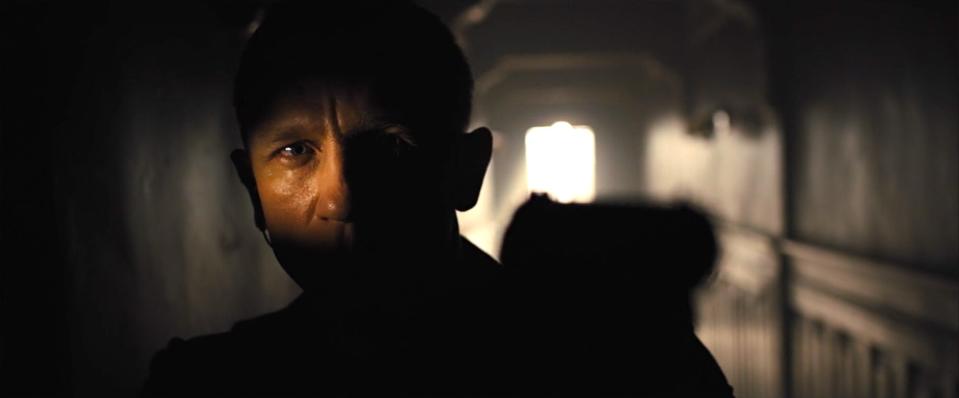
Columbia Pictures Daniel Craig's 007 emerges from the shadows in 'Skyfall'
"Sam had very clear idea of that sequence, and he wanted something very gritty and kind of Spy Who Came in from the Cold-feeling," Deakins says of Skyfall's memorable opening shot. "But also, he wanted this kind of iconic entrance for Daniel [Craig]. So that was quite a precise design he had in his mind, right down to the idea that there was a slash of light coming through a window or a door. And then I remember on the day, [after] setting the shot, I said to Sam, 'Well, yeah, it's really interesting, but what if we don't rack focus? What if we hold focus on the foreground and Daniel just walks into focus?' So that was something that just developed on the day. I think that's what's so exciting about making a movie: You can do so much prep and think it through, but on the day, things just sort of strike you."
A shot in the dark
Skyfall remains the only Bond movie to be shot entirely with digital cameras (Mendes opted to shoot primarily on film for his second go-round, Spectre, as did No Time to Die director Cary Fukunaga), and the decision paid big dividends for scenes like Bond's Shanghai showdown with the assassin Patrice. The camera's increased sensitivity allowed Deakins to light this scene almost entirely with large LED screens displaying colorful imagery, such as the glowing blue jellyfish that float by as Bond tangles with Patrice.
About those jellyfish: "One of the art directors, I think, found this piece of advert online, which was these jellyfish," Deakins recalls, and incorporated it into a model of the set used during preproduction. When it came time to decide what should actually be used in the film, "Sam and I looked at each other, and we went, 'Hey, what's wrong with the jellyfish? They're really cool,'" the cinematographer says with a laugh. "We just stuck with it, because it was sort of a strange, striking image, and I thought the speed with which they were floating was a great counter to the action that was happening in front."
As for the action, "Sam wanted to give each fight sequence its own identity, and for this one he was very much wanting to do the main fight as a single shot with that slow push-in," Deakins says. "That was always in mind in terms of how the set was going to be constructed, and what was going to be behind them and how they were going to be lit." Ergo, jellyfish.
Enter the dragon
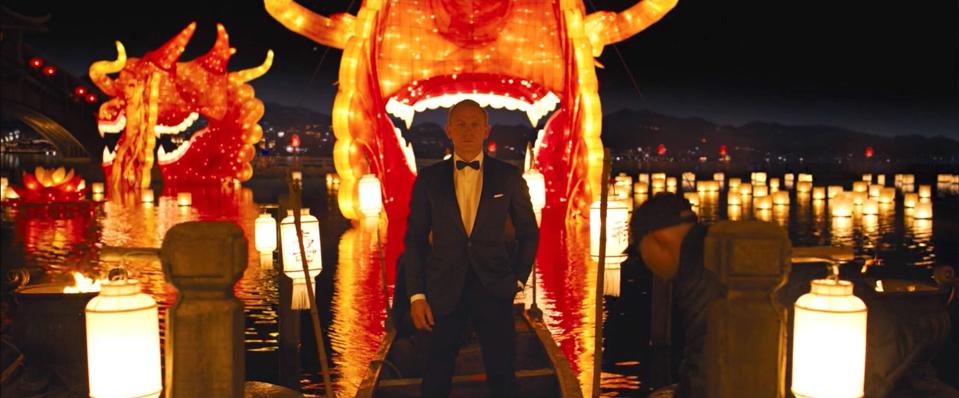
Columbia Pictures James Bond (Daniel Craig) arrives at a Macau casino in 'Skyfall'
Bond's grand entrance to a waterfront casino in Macau was shot at London's legendary Pinewood Studios, home of the franchise since the inaugural entry, Dr. No. "We scouted this temple on a lake near the outskirts of Shanghai, where we thought about doing it for real," recalls Deakins, "and you look at it and think, 'My God, how the hell are we going to do that?' I did, anyway," he adds with a laugh. Ultimately, "the complexity of doing that and going there for that one sequence was just too much."
Mendes and production designer Dennis Gassner first envisioned lion statues flanking the casino entrance, until Deakins aptly pointed out, "Where's the light coming from?" They settled on two large, illuminated dragon heads, along with 300 floating lanterns in the water, all of which were real (as were the fireworks in the scene, which the team set off on Pinewood's backlot). "Dennis found these experts in China, who came over to London and made these dragons in a workshop at Pinewood. It was amazing," Deakins says.
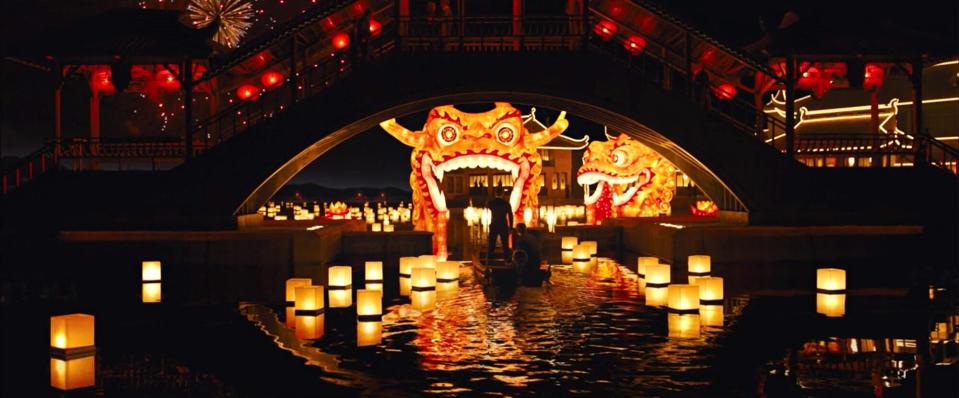
Columbia Pictures The Macau casino set in 'Skyfall' features two massive dragon heads built at London's Pinewood Studios.
It all made for one of Skyfall's most unapologetic moments of pure visual splendor, but one with a purpose: "We wanted it to feel exotic and inviting in a way, but it's also threatening," Deakins explains. "That scene seems kind of indulgent, but it is building up expectations when he goes in that casino, because that's quite a moment that it builds to. And there's also that very long interior Steadicam shot that takes Bond in. It was all about building expectation and tension, I suppose."
The fishbowl
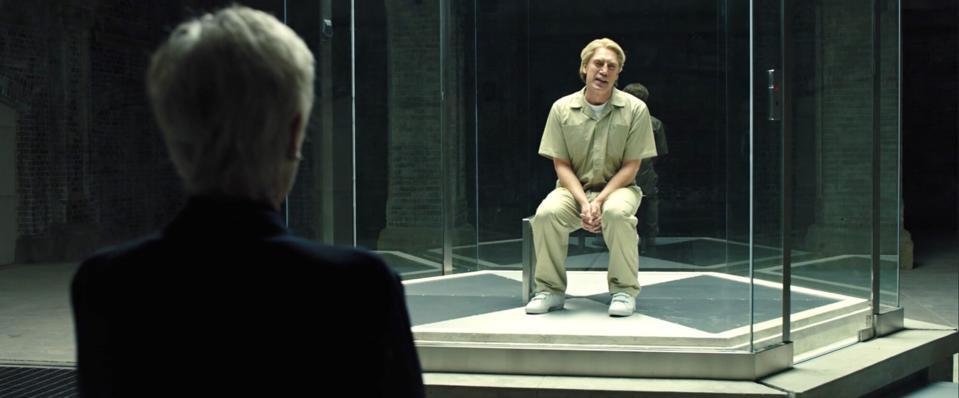
Columbia Pictures Raoul Silva (Javier Bardem) in his glass-box prison in 'Skyfall'
Glass (or otherwise transparent) prisons have long since become a pop-culture trope, but Skyfall's take still stands out, thanks in no small part to Deakins' subtle, eerily effective lighting of villain Raoul Silva (Javier Bardem) and his environs.
The cinematographer also credits Gassner's design: "I remember lots of conversations about what the prison should be," Deakins says. "Somebody — and I don't know who, but it was probably Dennis — had a wonderful idea of a sort of fish in a bowl, with Javier in this glass box. But then contrast that with the world that the box is in — you have this very Victorian underground London, and then this very high-tech glass box. I thought it was a great idea, and I really don't know where it came from.
"Then you get to, well, how is it lit?" he continues. "Because if it's just a glass box in a space, then it won't stand out unless you put a spotlight on it. I thought, 'Well, that's pretty ridiculous.' So that's why it's got a built-in light in the ceiling. It seemed most natural to the architecture of that space, and separated the glass-box world from the underground bunker."
Burning down the house
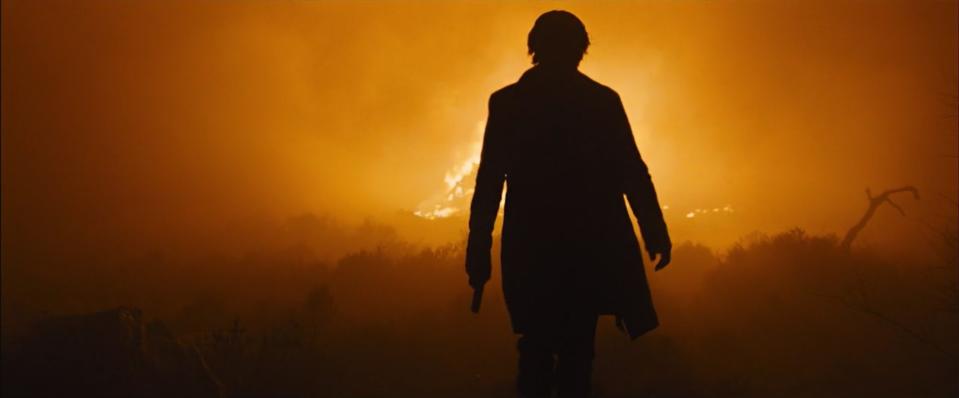
Columbia Pictures Hot stuff: Raoul Silva (Javier Bardem) silhouetted against the burning eponymous house in 'Skyfall'
Skyfall's climax, set at Bond's eponymous childhood home in the Scottish Highlands, was "the most tricky thing for me" on the film, Deakins says. The complex sequence, which takes place as night falls, required combining different shots filmed at different locations, while ensuring that the lighting would remain consistent across cuts. This striking shot of Bardem's Silva silhouetted against the burning house — a Deakins stylistic signature of sorts — is a perfect example.
"That shot was done on a [sound]stage, and the burning house is an element we shot on location," the cinematographer explains, with the two combined through visual effects. "The trick," as Deakins puts it, was "matching the real burning house and the amount of atmosphere" from the location shoot on the stage. The creative team used an elaborate lighting rig to mimic the flickering flames, similar to what Deakins had done on Mendes' 2005 film Jarhead.
"I was really determined that on location, and then matching it on stage, the only light source would be the burning house. By then, I wanted total darkness," Deakins says. However, "it's kind of a cheat, especially at the end, in the chapel," he adds with a laugh. "I mean, how you could really still have the burning house light the interior of a chapel — it's a bit of a stretch, but I thought it was better just to have that one light source."
Looking back on Skyfall nearly 10 years later, "I feel relieved that I got through it," Deakins says, laughing. "Not that it wasn't a great experience, but it seemed such a challenge, and you have your own expectations. I remember at the end of the shoot, I was relieved that I was pretty happy with most of it. And when I see it, I go, 'Yeah, that was alright, really.'" A statement as modest as his images aren't.
Read more from EW's 25 Days of Bond, a celebration of all things 007 ahead of the release of No Time to Die.
Related content:

